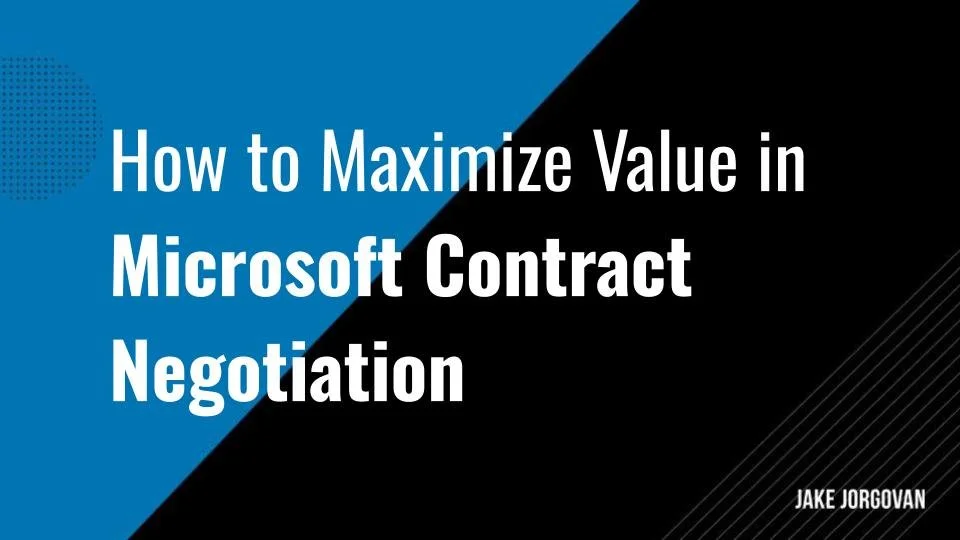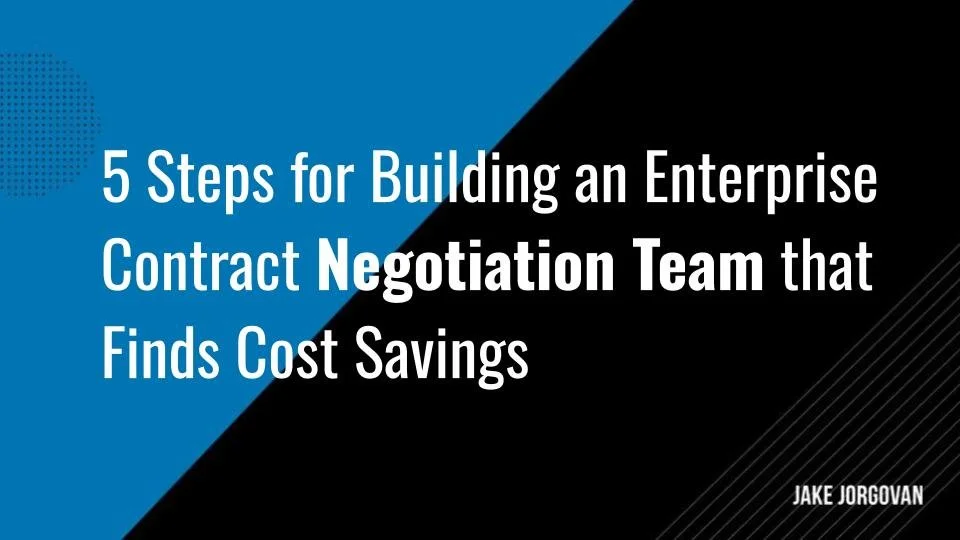7 Common Pitfalls in Salesforce Contract Negotiations and How to Avoid Them
Negotiating Salesforce contracts can be tricky. Missteps here can lead to unfavorable terms which can ripple out into bigger problems far into the future.
Your business deserves better. Understanding the common pitfalls around Salesforce contract negotiation is crucial. Knowing them puts you in control, and avoiding them saves money and time.
This article will guide you through key challenges, and offer practical strategies to navigate complex negotiations. Stay ahead by being informed — your bottom line depends on it.
7 Common Pitfalls in Salesforce Contract Negotiations and How to Avoid Them
1) Overlooking Hidden Costs and Fees
Overlooking hidden costs and fees in Salesforce contracts creates unexpected financial strain by impacting your budget and disrupting cash flow. These costs often go unnoticed until after the contract is signed.
Once locked in, you have little recourse. The charges accumulate. They drain resources meant for growth. Each hidden fee, whether for support, extra storage, or premium features, erodes your profitability.
By ensuring all fees are visible, understood, and justified, you’ll protect your bottom line, preserve your budget, and maintain control. Here’s how:
Review the Contract Line by Line: Start by carefully reading the entire contract. Don't skim through it. Focus on every detail.
Identify All Fees: Look for any fees that aren't immediately obvious. These can include administrative fees, support costs, and additional service charges.
Question Every Cost: If you see a fee that isn’t clear, ask your Salesforce representative to explain it. Don’t assume it’s standard or necessary.
Compare with Industry Standards: Benchmark these costs against industry norms. Salesforce can sometimes include charges that others don’t.
Negotiate: Challenge any fees that seem unnecessary or inflated. Push for their removal or reduction.
Document Agreements: Ensure that any changes to fees or costs are documented in the final contract.
Carefully following these steps allows you to avoid the trap of hidden costs and protect your budget.
2) Failing to Secure Flexible Contract Terms
Failing to secure flexible contract terms in Salesforce negotiations restricts your ability to adapt.
Over time, business needs evolve and markets change. Fixed terms lock you into rigid structures that can hinder growth. If you cannot scale services up or down, you risk paying for resources you don’t use or lacking those you need.
Without flexibility, renegotiation becomes costly — you lose leverage and your options narrow. To safeguard your business, secure contract terms that accommodate growth, change, and unforeseen demands.
Here’s how to do it:
Assess Your Business Needs: Start by understanding your current and future needs. Anticipate changes in scale, scope, and services.
Identify Inflexible Clauses: Go through the contract and identify terms that are rigid, such as fixed service levels, locked-in pricing, or strict usage limits.
Request Flexibility: Ask for contract terms that allow adjustments, such as scaling services up or down, changing features, or adjusting payment terms as your business evolves.
Negotiate Exit Options: Make sure there are clear exit strategies, including the ability to terminate or renegotiate the contract without excessive penalties if your needs change.
Document Agreed Flexibility: Make sure all agreed-upon flexible terms are explicitly written into the contract to avoid disputes later.
Review Regularly: Set a timeline for periodic reviews of the contract to ensure it remains aligned with your evolving business needs.
Securing flexible terms allows you to safeguard your business against unforeseen changes.
3) Underestimating Renewal and Escalation Clauses
Underestimating renewal and escalation clauses during Salesforce contract negotiations can severely impact your long-term costs.
These clauses often include automatic price increases or changes in terms at renewal. If you overlook them, you face unexpected cost hikes that strain your budget. Plus, these increases compound over time, and can quickly make your initially affordable contract unsustainable.
To protect your financial interests, you must scrutinize these clauses closely. Negotiate limits on price increases. Seek clarity on renewal terms. Document any agreed changes. This ensures you maintain control over costs and avoid unpleasant surprises when the contract renews.
Here’s how to get started:
Locate Renewal Clauses: Begin by identifying where the renewal terms are in the contract. They often appear near the end — don’t assume they’re straightforward.
Examine Renewal Conditions: Check the specifics of how renewals work. Are they automatic, or do you need to take action? Understand the timeline.
Identify Escalation Triggers: Look for clauses that allow Salesforce to increase prices upon renewal. Pay close attention to what triggers these increases.
Assess Impact on Budget: Calculate how these escalations will affect your long-term costs. Even a small percentage increase can significantly impact your budget over time.
Negotiate Cap on Increases: Negotiate a cap on price increases or push for fixed rates in renewals to protect your budget.
Get It in Writing: Ensure that any agreed-upon changes are clearly documented in the final contract.
Following these steps ensures you won’t be caught off guard by unexpected cost increases at renewal.
4) Neglecting to Address Data Ownership and Access Rights
Failing to address data ownership and access rights in Salesforce negotiations jeopardizes your control over critical assets. If you don’t secure clear terms, you risk losing access to your data, which can hinder operations and create dependency on Salesforce.
You may face difficulties extracting data if you change vendors, and this loss of control impacts your strategic flexibility. Always ensure you retain full ownership and secure unrestricted access. This protects your business’s autonomy and long-term success.
Here’s how:
Review Data Ownership Terms: Start by carefully reading the contract sections related to data. Identify who owns the data you input into Salesforce.
Clarify Ownership: Ensure the contract clearly states that your business retains full ownership of all data, including customer information, metrics, and content.
Examine Access Rights: Look at how and when you can access your data. Check that there are no restrictions on your ability to retrieve it, especially if you decide to leave Salesforce.
Negotiate Backup and Export Options: Demand the ability to back up and export your data regularly. Make sure this is available in a usable format that can be transferred to other systems.
Address Data Security: Be sure that the contract includes provisions for data security and privacy, particularly concerning how Salesforce handles and stores your data.
Document Everything: Ensure that all agreements on data ownership and access rights are clearly outlined in the contract.
Securing these terms allows you to protect your business’s most valuable asset: its data.
5) Ignoring Potential Future Scalability and Integration Needs
Ignoring potential future scalability and integration needs in Salesforce negotiations limits your ability to grow and adapt.
As your business expands, you may require more users, features, or integrations with other systems. If these needs aren’t addressed upfront, you face higher costs or technical barriers later. This restricts your flexibility and can stall growth and create operational inefficiencies.
Always make sure the contract accommodates future expansion and possibilities for integration.
Here’s how to do it:
Project Future Growth: Start by analyzing your business's growth trajectory. Consider how your needs might evolve in the next 2-5 years.
Identify Scalability Requirements: Work out how Salesforce will need to scale with your business. Look for limits on users, data storage, or feature sets that could hinder growth.
Evaluate Integration Needs: Assess which systems and tools you currently use and may adopt in the future. Check if Salesforce can easily integrate with these technologies.
Negotiate Scalability Options: Make sure the contract includes terms that allow easy expansion. Push for options to add users, increase storage, or access additional features without renegotiating the entire contract.
Secure Integration Capabilities: Confirm that Salesforce supports integration with your existing and potential future systems. Request APIs or middleware solutions if needed.
Document Future-Proofing Terms: Ensure that all scalability and integration agreements are explicitly detailed in the contract.
Addressing these needs now prevents costly limitations down the road.
6) Accepting Standard Terms without Customization
Accepting standard terms without customization during Salesforce negotiations compromises your business’s unique needs.
Here’s why: standard terms often favor the vendor — they may include rigid pricing, limited support, or inflexible service levels. If you don’t tailor these terms, you risk paying for services that don’t fully align with your operations. This leads to inefficiencies and can cause you to lose leverage.
Customization, on the other hand, allows you to secure terms that match your specific requirements. Insist on adjustments, and protect your business interests.
Here’s how to get started:
Review Standard Terms: Start by thoroughly reading the standard contract terms provided by Salesforce. Understand that, oftentimes, these terms are designed to favor the vendor, not your business.
Identify Key Areas for Customization: Pinpoint contract sections that impact your specific needs, such as service levels, pricing, support, and termination clauses.
Assess Business Impact: Think about how the standard terms could limit your operations or increase costs. Consider your industry, company size, and unique requirements.
Propose Custom Terms: Develop a list of modifications tailored to your business needs. These might include flexible payment schedules, better support, or customized service levels.
Negotiate: Present your proposed changes to Salesforce. Be firm in requesting adjustments that align the contract with your business goals.
Document All Changes: Ensure every agreed-upon customization is explicitly written into the final contract. Verbal agreements are not enough.
Customizing the contract ensures it works for your business, not just for Salesforce.
Insider tip: We always advise our clients to negotiate for a "Most Favored Nation" clause in their Salesforce contracts. This clause makes sure that if Salesforce offers better terms or pricing to another customer of similar size and scope during your contract period, they must extend those same terms to you. It's a powerful way to protect your interests and ensure you're getting the best possible deal.
7) Rushing the Negotiation Process Under Time Pressure.
Rushing the negotiation process under time pressure can easily lead to missed details and unfavorable terms.
When you rush, you sacrifice thorough review, and critical contract elements may be overlooked. This exposes your business to hidden costs, inflexible terms, or unfavorable renewal conditions.
Time pressure often forces quick decisions, and these decisions can cost you significantly in the long run. Always allocate sufficient time and ensure each clause is carefully evaluated.
Here’s how:
Recognize the Pressure: First, find out if you’re facing any deadlines or pressure to finalize the Salesforce contract quickly. Acknowledge that rushing can lead to costly mistakes.
Pause and Prioritize: Stop and prioritize key contract areas that require a thorough review. Focus on terms that have the most significant impact on your business, like pricing, service levels, and exit clauses.
Extend Timelines: Request more time from Salesforce if needed. Explain that you need additional time to ensure the contract aligns with your business goals. Most vendors are willing to accommodate reasonable requests.
Involve Stakeholders: Have all relevant departments, like legal, finance, and IT, review the contract. Get their input so you don’t overlook critical details.
Negotiate Without Haste: Approach negotiations methodically. Don’t agree to terms simply to meet a deadline. Be sure that every clause is reviewed and understood.
Rushing can lead to unfavorable terms. Take your time if you want to secure the best possible outcome for your business.
Get More Out of Your Salesforce Contract Negotiations
Navigating Salesforce contract negotiations is crucial, and missteps here can lead to costly consequences. However, when armed with the right information and strategies you can avoid these pitfalls and secure better deals that don’t develop into future problems.
Remember — don’t rush. Customize the contract to fit your needs, ensure flexibility, and protect your data. By addressing these areas, you’ll secure a deal that works for you, long-term. Your business deserves a contract that supports its growth, not one that hinders it.



























